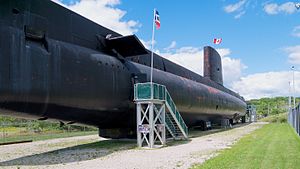HMCS Ojibwa (S72)

HMCS Ojibwa as museum vessel in Port Burwell, Ontario.
|
|
| History | |
|---|---|
|
|
|
| Name: | Onyx |
| Builder: | Chatham Dockyard, Chatham |
| Laid down: | 27 September 1962 |
| Fate: | Sold to Canada while under construction |
|
|
|
| Name: | Ojibwa |
| Namesake: | Ojibwa First Nations people |
| Launched: | 29 February 1964 |
| Acquired: | 1963 |
| Commissioned: | 23 September 1965 |
| Decommissioned: | May 1998 |
| Identification: | S 72 |
| Status: | As of November 2012[update] - now in Port Burwell, Ontario on permanent display |
| Badge: | Blazon Azure, an escallop shell erect argent irradiated by nine ears of wild rice or, all issuing from two barrulets wavy of the last, in base. |
| General characteristics | |
| Class and type: | Oberon-class submarine |
| Displacement: |
|
| Length: | 295.25 ft (89.99 m) |
| Beam: | 26.5 ft (8.1 m) |
| Draught: | 18 ft (5.5 m) |
| Propulsion: |
|
| Speed: |
|
| Range: | 9,000 nautical miles (17,000 km; 10,000 mi) at 12 kn (22 km/h; 14 mph) |
| Endurance: | 258 t of oil, 56 days |
| Test depth: | 120 metres (390 ft)-180 metres (590 ft) |
| Complement: | 69 |
| Sensors and processing systems: |
|
| Electronic warfare & decoys: |
MEL Manta UAL or UA4 radar warning |
| Armament: | 8 × 21 in (530 mm) tubes (6 bow, 2 stern), 30 torpedoes |
HMCS Ojibwa was an Oberon-class submarine that served in the Royal Canadian Navy (RCN) and later the Canadian Forces Maritime Command (MARCOM). Originally intended for service with the Royal Navy as HMS Onyx, the submarine was transferred to Canadian ownership before completion, and entered RCN service in 1965. Ojibwa operated primarily with Maritime Forces Atlantic until her decommissioning in 1998. In 2010, Ojibwa was laid up at CFB Halifax awaiting disposal, with the Elgin Military Museum planning to preserve her as a museum vessel. The submarine was towed to Port Burwell, Ontario in 2012, and was opened to the public in 2013. She is now the new focal point of a planned Museum of Naval History to be built alongside.
The Oberon class were considered an improved version of the preceding Porpoise-class submarines, with a different frame of the pressure hull and constructed from a better grade of steel. These build differences allowed the Oberons to have a deeper diving depth at roughly 1,000 feet (300 m).
The submarines displaced 2,030 tonnes (2,000 long tons) surfaced and 2,410 tonnes (2,370 long tons) submerged. They measured 295 ft 1⁄4 in (89.922 m) long with a beam of 26 ft 1⁄2 in (7.938 m) and a draught of 18 ft (5.5 m).
The boats were powered by a two shaft diesel-electric system. The Oberons were equipped with two ASR 1 16-cylinder diesel engines creating 3,680 brake horsepower (2,740 kW) and two English Electric motors creating 6,000 shaft horsepower (4,500 kW). This gave the submarines a maximum surface speed of 12 knots (22 km/h; 14 mph) and a submerged speed of 17 knots (31 km/h; 20 mph). The boats carried 258 tons of oil giving them a range of 9,000 nautical miles (17,000 km; 10,000 mi) at 12 knots.
...
Wikipedia
